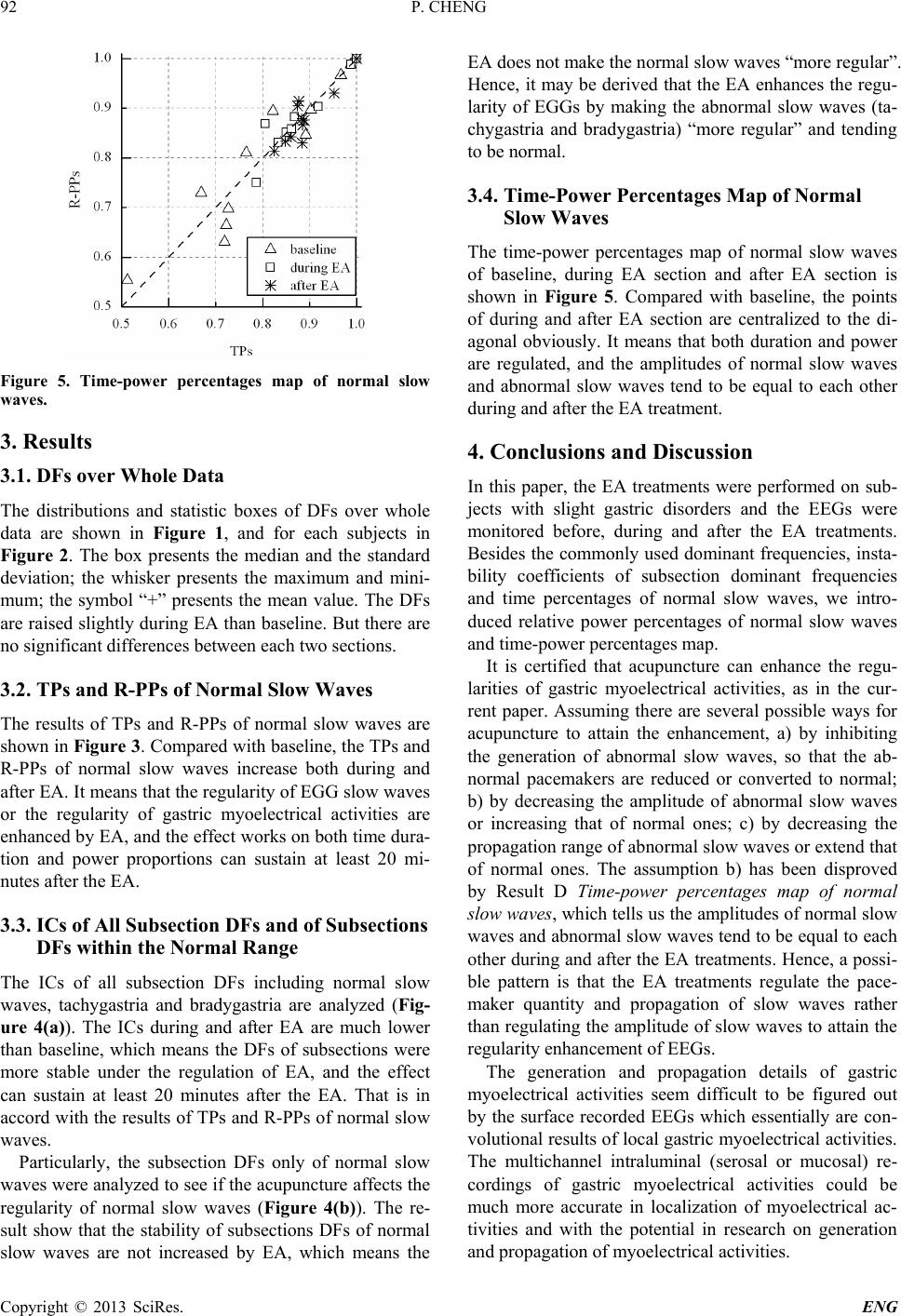
P. CHENG
Copyright © 2013 SciRes. ENG
Figure 5. Time-power percentages map of normal slow
waves.
3. Results
3.1. DFs over Whole Data
The distributions and statistic boxes of DFs over whole
data are shown in Figure 1, and for each subjects in
Figure 2. The box presents the median and the standard
deviation; the whisker presents the maximu m and mini-
mum ; the symbol “+” presents the mean value. The DFs
are raised slightly during EA than b aseline. But the re are
no significant differences between each two sections.
3.2. TPs and R-PPs of Normal Slow Waves
The results of TPs and R-PPs of normal slow waves are
shown in Figure 3. Compared with baseline, the TPs and
R-PPs of normal slow waves increase both during and
after EA. It means that the regularity of EGG slow waves
or the regularity of gastric myoelectrical activities are
enhanced by EA, and the effect works on both time dur a-
tion and power proportions can sustain at least 20 mi-
nutes after the EA.
3.3. ICs of All Subsection DFs and of Subsections
DFs within the Normal Range
The ICs of all subsection DFs including normal slow
waves, tachygastria and bradygastria are analyzed (Fig-
ure 4(a)). The ICs during and after EA are much lower
than baseline, which means the DFs of subsections were
more stable under the regulation of EA, and the effect
can sustain at least 20 minutes after the EA. That is in
accord with the results of TPs and R-PPs of normal slow
waves.
Particularly, the subsection DFs only of normal slow
waves were analyzed to see if the acupuncture affects the
regularity of normal slow waves (Figure 4( b)). The re-
sult show that the stability of subsections DFs of normal
slow waves are not increased by EA, which means the
EA does not make the normal slow waves “more regular”.
Hence, it may be derived that the EA enhances the regu-
larity of EGGs by making the abnormal slow waves (ta-
chygastria and bradygastria) “more regular” and tending
to be normal.
3.4. Time-Power Percenta ges Map of Normal
Slow Waves
The time-power percentages map of normal slow waves
of baseline, during EA section and after EA section is
shown in Figure 5. Compared with baseline, the points
of during and after EA section are centralized to the di-
agonal obviously. It means that both duration and power
are regulated, and the amplitudes of normal slow waves
and abnormal slow waves tend to be equal to each other
during and after the EA treatment.
4. Conclusions and Discussion
In this paper, the EA treatments were performed on sub-
jects with slight gastric disorders and the EEGs were
monitored before, during and after the EA treatments.
Besides the commonly used dominant frequencies, insta-
bility coefficients of subsection dominant frequencies
and time percentages of normal slow waves, we intro-
duced relative power percentages of normal slow waves
and time-power percentages map.
It is certified that acupuncture can enhance the regu-
larities of gastric myoelectrical activities, as in the cur-
rent paper. Assuming there are several possible ways for
acupuncture to attain the enhancement, a) by inhibiting
the generation of abnormal slow waves, so that the ab-
normal pacemakers are reduced or converted to normal;
b) by decreasing the amplitude of abnormal slow waves
or increasing that of normal ones; c) by decreasing the
propagation range of abnormal slow waves or extend that
of normal ones. The assumption b) has been disproved
by Result D Time-power percentages map of normal
slow waves, which tells us the amplitudes of normal slow
waves and abnormal slow waves tend to be equal to each
other during and after the EA treatments. Hence, a possi-
ble pattern is that the EA treatments regulate the pace-
maker quantity and propagation of slow waves rather
than regulating the amplitude of slow waves to attain the
regularity enhancement of EEGs.
The generation and propagation details of gastric
myoelectrical activities seem difficult to be figured out
by the surface recorded EEGs which essentially are con-
volutional results of loca l gastric myoelectrical activities.
The multichannel intraluminal (serosal or mucosal) re-
cordings of gastric myoelectrical activities could be
much more accurate in localization of myoelectrical ac-
tivities and with the potential in research on generation
and propagation of myoelectrical activities.